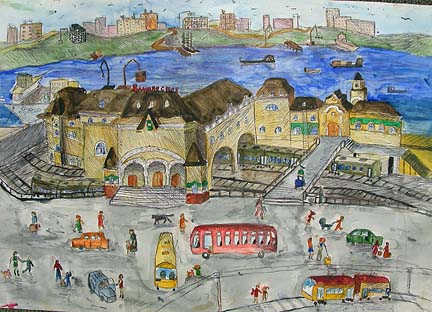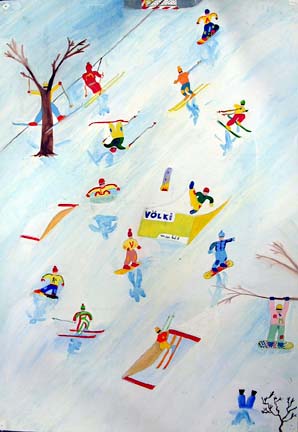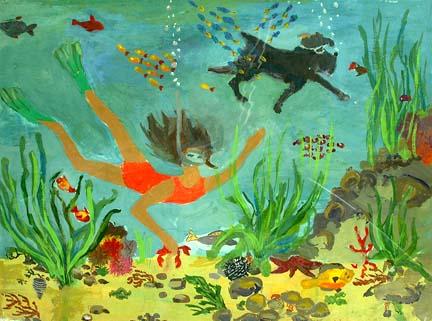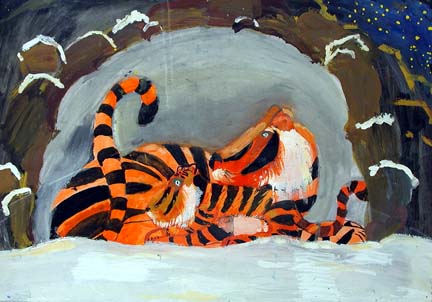
[ LOCAL COLOR ]
Joleen Oshiro
A sketch of Vladivostok, Russia, where students of The First Children's Art School live. Their work is on display at the Honolulu Academy of Arts through July 26.
Youthful eyes
Russian art students' diverse and
engaging works are on display
at the Academy of ArtsORIGINATING from one of the richest, most powerful countries on the planet, American culture influences youths of other societies with unflagging regularity. Think of the appeal of Coca-Cola and Levis jeans. This dynamic is so commonplace that we rarely ponder the phenomenon. Given our usual perspective as exporters of youth culture, it's valuable for us to learn how other societies cultivate their youth.
The Honolulu Academy of Arts provides us the opportunity with "Russia in the Eyes of Children," an exhibition of works by students of the First Children's Art School, Vladivostok. The academy is opening the exhibit with a "Russian Folk Festival" which includes performances of Russian folk dancing, music inspired by folk literature, storytelling, art activities for children and a video of "Peter and the Wolf."
"The most important aim to reach is to open the children's souls to the arts and let them feel the art process as part of their everyday life." -- First Children's Art School, Vladivostok
A village scene in the spring.
The First Children's Art School has been serving its mission well. The 36-year-old institution, which is part of the city of Vladivostok's Department of Culture, has sprouted young artists whose works have toured the globe and reaped awards in international children's art competitions.
The first-time viewer is engaged instantly by the enthusiasm the works embody, a reflection of the energy that all children possess. The colorful paintings and sketches depict the Russian landscape, lifestyle and seasons in all their captivating versatility.
"They're just delightful vignettes," says Karen Thompson, curator of education at the academy. "We were impressed, for example, by the busyness of the Vladivostok city scenes. And the snow scenes had a marvelous way of capturing light. It makes you feel cold."
Other works depict holidays such as Russian New Year, similar to an American Christmas scene, with its decorated trees, snow and Santa Claus, who's referred to as Grandfather Frost. There are lush, idyllic village portraits of spring, historical Viking scenes and depictions of Siberian tigers. And there are even ocean scenes.
This whimsical skiing scene illustrates how the students are able to capture light in their works.
"We first thought that we were looking at pictures of Hawaii," Thompson says. "Then I looked at a map of Vladivostok and found that they do have a beach. In fact, the university there offers oceanic study."
THE DIVERSITY of the artwork from tigers in the snow to underwater vistas, reflect the vast expanse of Russia, the world's largest country. Russia is divided by the Ural Mountains, which separate European Russia, where most of the population resides, from Asian Russia, which includes frigidly cold Siberia. The Russian Far East includes 6,000 miles of coastline extending from the Arctic Circle to the Sea of Japan.
Vladivostok, a port city of 700,000, is located across the Sea of Japan from Honshu and less than 70 miles east of China. The heart of the city is the port, with its miles of wharves, warehouses and docks. Commercial fishing and shipping are the city's primary industries, and many international businesses are based in the city to take advantage of its location as a crossroads of Northeast Asia.
Russians beaches? It's true. Russians are able to enjoy water recreation during summer months.
Vladivostok is also the terminus of the Trans Siberian Railway and the Orient Express. Students' portraits of their hometown reflect the bustling city life and the energy of movement into and out of Vladivostok from the water and railways.
WHILE the Vladivostok artwork stands solidly on its own, a full-bodied show, "Russia Through the Eyes of Children" can be most aptly defined as an interactive cultural education exhibition.
"We sent disposable cameras to Vladivostok and asked the kids to take pictures of themselves at school. We wanted to show where they're coming from. But not only did they do that, they sent their own pictures from their home life and wrote letters to us," Thompson says.
One Vladivostok student writes: "I am going to art school. Drawing is my favourite hobby. I pay great attention for studying English. In my free time I like growing flowers. I have a wonderful collection of cactus, the most part of which I brought from Southern towns of China. I enjoyed traveling in China. I would like to learn more about your country and to meet a good friend in it. Will you write me a letter please?"
Spring-boarding from the artists' enthusiastic response, Thompson and company decided to display the snapshots and letters together, along with paper, pencils and a mailbox, from which young visitors may write and send their own responses to the Vladivostok youths.
A painting of Siberian tigers.
Other features of the exhibit include a computer that translates a person's name into Russian, a video of Russian children performing traditional dances, displays of traditional 3-D Russian folk art, a reading area with books of Russian stories and crafts for children.
The academy's press packet on the First Children's Art School says that "the art teachers' enthusiasm, energy and new ideas encourage creativity as the students learn new ways to look at and interpret the world around them." In partnership with the efforts of Thompson and the academy, the Vladivostok students' works are performing much the same function for the vision of isle youths.
"Russian Family Festival"
Where: Honolulu Academy of Arts, 900 S. Beretania St.
When: 1 to 4 p.m. today
Admission: Free
"Russia Through the Eyes of Children"
Where: Honolulu Academy of Arts, 900 S. Beretania St.
When: 10 a.m. to 4:30 p.m. Tuesdays to Saturdays, 1 to 5 p.m. Sundays through July 26
Admission: $7 general; $4 students, seniors, military; free for children 12 and under
Call: 532-8700
Click for online
calendars and events.





